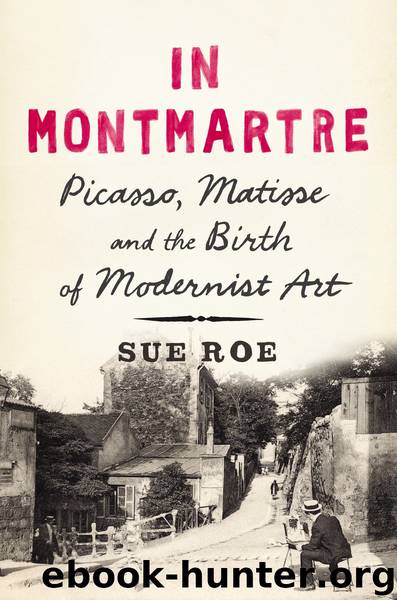In Montmartre: Picasso, Matisse and the Birth of Modernist Art by Sue Roe

Author:Sue Roe [Roe, Sue]
Language: eng
Format: epub
Tags: Art, Non-Fiction, Biography, History
ISBN: 9781594204951
Barnesnoble:
Goodreads: 22571501
Publisher: Penguin Press
Published: 2014-07-30T23:00:00+00:00
3.
Motion Pictures
In Paris, by autumn 1907 everyone was going to the movies. During the previous six or seven years, technological advances had been rapid. Cinema audiences could now see historical films, chase films, even drama documentaries – the first biopics. Picasso and his friends had started going to the pictures at least once a week, on Fridays when the programmes changed, an innovation introduced that August, when Pathé began to distribute films for rent. (Until then, cinema venues had bought film priced by the metre and used the print until it wore out and was melted down to make new stock.) The cinema now vied with the circus as Picasso’s all-consuming passion. Film actors were being recruited from theatres, music halls and circuses and the actors themselves becoming the main draw; people now went to see a film because of its star. Posters on Morris columns all over Paris appealed to prospective cinema audiences with glamorous photographs of the new cinema stars, many of whom had already made their names in the theatre. One of the painters in Montmartre found a way of earning a few sous as a stuntman when all the professional actors turned the job down as too dangerous. He became so successful he gave up painting, and the Bateau-Lavoir gang went to the open-air cinema in the rue de Douai to see him in Zigoto se suicide and Calino cambrioleur (Zigoto Commits Suicide and Calino the Burglar).
By now, Fernande, too, was captivated, particularly by the heady appeal of the female stars. She modelled herself on the vamps and sirens of the screen and, thanks to the steadily increasing numbers of purchasers for Picasso’s work, had taken to wearing extravagant outfits and hats top-heavy with feathers which looked, someone remarked, like an aviary in the Jardin des Plantes. The cinema, for Fernande, at least, had become associated with glamour. And the quality of films was improving all the time. More films were colour-tinted, the tinting and stencilling done by Pathé’s growing workforce. Over 1,200 workers, many of them female, had found employment splicing and colouring prints, a process similar to work they would otherwise have done in the textile factories. Le Pêcheur des perles (1907) was one such visually spectacular rags-to-riches story enhanced by tinting and stencil colour.
That year, hundreds of permanent cinema venues sprang up all over Paris. The first, the 300-seat Omnia-Pathé, next to the Théâtre des Variétés, had opened on 15 December the previous year. On the place de Clichy, the giant Hippodrome, formerly one of the major circus arenas, debuted as a cinema, and by December 1907 the Cirque d’Hiver’s programmes also included films. Already by the summer, there were at least fifty new or converted permanent cinemas throughout the city, with posters on every wall, advertising films designed to appeal to audiences of all ages, from every social class. The main attractions were often Georges Méliès’ new ‘longer’ films (five or ten minutes in duration; sometimes more), featuring increasingly eye-catching special effects. The programmes were interspersed with lantern slide shows and live vaudeville acts.
Download
This site does not store any files on its server. We only index and link to content provided by other sites. Please contact the content providers to delete copyright contents if any and email us, we'll remove relevant links or contents immediately.
The Art of Boudoir Photography: How to Create Stunning Photographs of Women by Christa Meola(18537)
Red Sparrow by Jason Matthews(5390)
Harry Potter 02 & The Chamber Of Secrets (Illustrated) by J.K. Rowling(3620)
In a Sunburned Country by Bill Bryson(3481)
Drawing Cutting Edge Anatomy by Christopher Hart(3454)
Figure Drawing for Artists by Steve Huston(3381)
Harry Potter and the Prisoner of Azkaban (Book 3) by J. K. Rowling(3304)
The Daily Stoic by Holiday Ryan & Hanselman Stephen(3230)
Japanese Design by Patricia J. Graham(3109)
The Roots of Romanticism (Second Edition) by Berlin Isaiah Hardy Henry Gray John(2878)
Make Comics Like the Pros by Greg Pak(2852)
Stacked Decks by The Rotenberg Collection(2811)
Draw-A-Saurus by James Silvani(2655)
Harry Potter and the Deathly Hallows (7) by J.K. Rowling(2641)
Tattoo Art by Doralba Picerno(2600)
On Photography by Susan Sontag(2575)
Churchill by Paul Johnson(2506)
The Daily Stoic by Ryan Holiday & Stephen Hanselman(2459)
Drawing and Painting Birds by Tim Wootton(2438)
